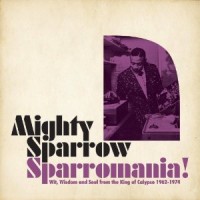The following review of the 2012 compilation of the music of Slinger Francisco, the Mighty Sparrow, was written by David Lewis and appears in the May 2012 issue of Black Grooves.
Artist: Mighty Sparrow
Label: Strut / K7!
Formats: 2-CD set, 2-LP set, MP3
Catalog No.: Strut090CD
Release date: January 24, 2012
Any collection dedicated to the work of Slinger Fransisco, better known in the Caribbean by his calypso sobriquet Mighty Sparrow, is going to be woefully incomplete. So any review of such a collection could easily turn into bellyaching about material that is missing. I’ll refrain from that, but will note that by focusing their collection Sparromania! on Sparrow’s career from 1960-1972, listeners will miss some of Sparrow’s memorable pieces such as the iconic “Jean and Dinah,” the popular “Drunk and Disorderly” and the racy double-entendre song “Saltfish.”
Those concerns aside, this compilation showcases Sparrow’s penchant for biting social commentary that earned him the title “Calypso King of the World.” His insightful commentary on “Kennedy and Kruschev” shows Sparrow at the top of his game, both lyrically and musically, with a driving rhythm section and quips on world affairs. His social commentary on “Ah Digging Horrors” is still applicable to Trinidad’s current struggles with high crime rates and the economic downturn, years after it was originally written:
Ah digging horrors, ah digging the blues
Anytime I choose to peruse the daily news
Ah digging horrors because
All I read about is kidnappers, more laws, and wars. (see the following you tube video)
Sparrow’s genius with the witty, oratorical calypso form can be heard in the track entitled “Picong Duel (Sparrow and Melody).” Picong is a West Indian speech form where speakers trade witty banter and comic insults in a spirit of good fun. Picong is deeply intertwined with the history of calypso and still appears today in “extempo” (improvised calypso) competitions. This exchange pairs the two giants of calypso, Sparrow and Lord Melody.
The collection also delves into Sparrow’s experiments with non-calypso genres during this period, such as the jangly ‘60s pop sounds of “She’s Been Gone Too Long” or the calypso-fied version of “Try a Little Tenderness.” Purists will lament the wasted space: why include songs like this when there are worthy, socially relevant calypsos that are left by the wayside? While some of these “excursions” into other genres are not of the same musical or lyrical quality as Sparrow’s true-true calypsos, they document the growth and change in the calypso form itself throughout the 1960s. The influence of U.S. based pop and the growing international success of reggae inspired calypsonians to experiment with pop and soul sounds which would eventually solidify into a new “spinoff” genre: soca.
And while many of these experiments ultimately do not stand up to Sparrow’s other output, one of my favorite tracks on the compilation is the raucous “What’s the Use of Getting Sober?” A lazy shuffling guitar accompanies Sparrow and a few friends as they express their love of Trinidad rum:
Here comes the bottle, I gotta get some
I want my mouth to smell stink with rum!
What’s the use of getting sober
When you know you will be drunk again?
Indeed.
While calypso fans may have many of these recordings on albums from the 1960s and ‘70s, many of the originals—and even Sparrow’s CD releases of the material—have been difficult to find in the United States. The extensive liner notes by David Katz on the history of calypso and Sparrow’s career make this a great introduction to a small slice of his musical output.
For original post: Sparromania!: Wit, Wisdom, and Soul from the King of Calypso, 1960-1976 | blackgrooves.org.
